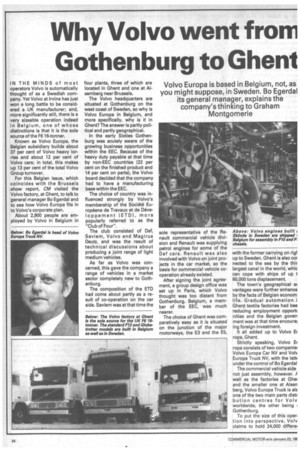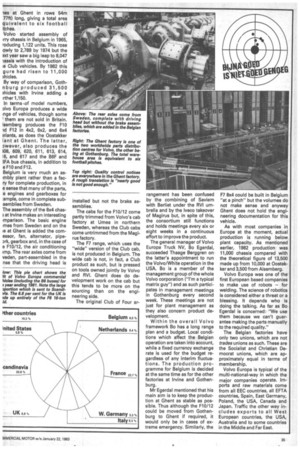Why Volvo went from Gothenburg to Ghent
Page 36

Page 37

If you've noticed an error in this article please click here to report it so we can fix it.
Volvo Europa is based in Belgium, not, as you might suppose, in Sweden. Bo Egerdal its general manager, explains the company's thinking to Graham Montgomerie
IN THE MINDS of most operators Volvo is automatically thought of as a Swedish company. Yet Volvo at Irvine has just won a long battle to be considered a UK manufacturer; and, more significantly still, there is a very sizeable operation indeed in Belgium, one of whose distinctions is that it is the sole source of the F6 16-tonner.
Known as Volvo Europa, the Belgian subsidiary builds about 37 per cent of Volvo heavy lorries and about 12 per cent of Volvo cars; in total, this makes up 13 per cent of the total Volvo Group turnover.
For this Belgian issue, which coincides with the Brussels show report, CM visited the Volvo factory, at Ghent, to talk to general manager Bo Egerdal and to see how Volvo Europa fits in to Volvo's corporate plan.
About 2,900 people are employed by Volvo in Belgium in four plants, three of which are located in Ghent and one at Alsemberg near Brussels.
The Volvo headquarters are situated at Gothenburg on the west coast of Sweden, so why is Volvo Europa in Belgium, and more specifically, why is it in Ghent? The answer is partly political and partly geographical.
In the early Sixties Gothenburg was acutely aware of the growing business opportunities within the EEC. Because of the heavy duty payable at that time by non-EEC countries (22 per cent on the finished product and 14 per cent on parts), the Volvo board decided that the company had to have a manufacturing base within the EEC.
The choice of country was influenced strongly by Volvo's membership of the Societe Europeene de Travaux et de Nyeloppement (ETD), more popularly referred to as the "Club of Four".
The club consisted of Daf, Saviem, Volvo and Magirus Deutz, and was the result of technical discussions about producing a joint range of light medium vehicles.
As far as Volvo was concerned, this gave the company a range of vehicles in a market sector completely new to Gothenburg.
The composition of the ETD had come about partly as a result of co-operation on the car side. Saviem was at that time the sole representative of the Renault commercial vehicle division and Renault was supplying petrol engines for some of the Daf cars. Renault was also involved with Volvo on joint projects in the car market, so the basis for commercial vehicle cooperation already existed.
After signing the joint agreement, a group design office was set up in Paris, which Volvo thought was too distant from Gothenburg. Belgium, a member of the EEC, was much nearer.
The choice of Ghent was comparatively easy as it is situated on the junction of the major motorways, the E3 and the E5, with the former carrying on rigi up to Sweden. Ghent is also cor nected to the sea by the thir largest canal in the world, whic can cope with ships of up t 60,000 tons displacement.
The town's geographical ac vantages were further enhance by the facts of Belgian economi life. Gradual automation i Ghent textile factories had bee reducing employment opportt nities and the Belgian goveri ment was at that time encoura ing foreign investment.
It all added up to Volvo Et ropa, Ghent.
Strictly speaking, Volvo Et rope consists of two companiel Volvo Europa Car NV and Volv Europa Truck NV, with the lett( under the control of Bo Egerdal The commercial vehicle side not just assembly, however. well as the factories at Gher and the smaller one at Alsen berg, Volvo Europa Truck is als one of the two main parts distr bution centres for Volv worldwide, the other being Gothenburg.
To put the size of this open tion into perspective, Volv claims to hold 24,000 differei les at Ghent in rows 54m 77ft) long, giving a total area quivalent to six football Itches.
Volvo started assembly of Irry chassis in Belgium in 1965, roducing 1,122 units. This rose owly to 2,789 by 1974 but the ?xt year saw a big leap to 8,047 lassis with the introduction of le Club vehicles. By 1982 this gure had risen to 11,000 )hicles.
By way of comparison, Gothnburg produced 31,500 )hicles with Irvine adding a Irther 1,150.
In terms \of model numbers, 31vo Europa produces a wide Inge of vehicles, though some them are not sold in Britain. lsemberg produces the F10 Id F12 in 4x2, 6x2, and 6x4 Merits, as does the Oostakker lant at Ghent. The latter, awever, also produces the 108, 609, 620, 611, 613, 614, 16, and 617 and the B6F and WA bus chassis, in addition to e F10 and F12.
Belgium is very much an asImbly plant rather than a facry for complete production, in e sense that many of the parts, e engines and gearboxes for 'ample, come in complete subsemblies from Sweden.
The assembly of the 8x4 chas; at Irvine makes an interesting Imparison. The basic engine Imes from Sweden and on the le at Ghent is added the comessor, fan, alternator, pipe)rk, gearbox and, in the case of • F10/12, the air conditioning imp. The rear axles come from veden, part-assembled in the nse that the driving head is installed but not the brake assemblies.
The cabs for the F10/12 come partly trimmed from Volvo's cab factory at Umea in northern Sweden, whereas the Club cabs come untrimmed from the Magirue factory.
The F7 range, which uses the "wide" version of the Club cab, is not produced in Belgium. The wide cab is not, in fact, a Club product as such, but is pressed on tools owned jointly by Volvo and RVI. Ghent does do development work on the cab but this tends to be more on the sourcing than on the engineering side.
The original Club of Four ar rangement has been confused by the combining of Saviem with Berliet under the FIVI umbrella and by the Iveco takeover of Magirus but, in spite of this, the consortium still functions and holds meetings every six or eight weeks in a continuous effort to improve the product.
The general manager of Volvo Europa Truck NV, Bo Egerdal, succeeded Thaage Berggren on the latter's appointment to run the Volvo/White operation in the USA. Bo is a member of the management group of the whole Volvo corporation ("I'm a typical matrix guy") and as such participates in management meetings in Gothenburg every second week. These meetings are not just for plant management as they also concern product development.
Within the overall Volvo framework Bo has a long range plan and a budget. Local conditions which affect the Belgian operation are taken into account, while a fixed currency exchange rate is used for the budget regardless of any interim fluctuations. The production programme for Belgium is decided at the same time as for the other factories at Irvine and Gothenburg.
Mr Egerdal mentioned that his main aim is to keep the production at Ghent as stable as possible. Thus although the F10/12 could be moved from Gothenburg to Ghent if required, it would only be in cases of extreme emergency. Similarly, the F7 8x4 could be built in Belgium "at a pinch" but the volumes do not make sense and anyway Ghent does not hold the engineering documentation for this vehicle.
As with most companies in Europe at the moment, actual production is running below plant capacity. As mentioned earlier, 1982 production was 11,000 chassis compared with the theoretical figure of 13,500 made up from 10,000 at Oostakker and 3,500 from Alsemberg.
Volvo Europa was one of the first European based companies to make use of robots — for welding. The science of robotics is considered either a threat or a blessing. It depends who is doing the talking. As far as Bo Egerdal is concerned: "We use them because we can't guarantee making the parts manually to the required quality."
The Belgian factories have only two unions, which are not trades unions as such. These are the Socialist and Christian Democrat unions, which are approximately equal in terms of membership.
Volvo Europa is typical of the multi-national-way in which the major companies operate. Imports and raw materials come from all EEC countries, all EFTA countries, Spain, East Germany, Poland, the USA, Canada and Japan. Traffic the other way includes exports to all West European countries, the USA, Australia and to some countries in the Middle and Far East.




















































































